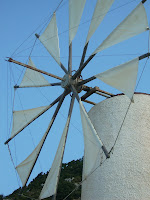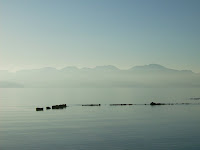The plateau is one of Crete's outstanding attractions. We took the old road to Iraklion and left the road at the market town of Neapoli. Neapoli was founded in the 16th century under the name of Neo Chorio (new village), then under Turkish rule it was changed from new villlage to new town; Neapolis.
We followed a winding road which climbs 19 miles into the mountains, passing through the villages of Vryses, Zenia and Exo Potami, then along a river valley lined with oaks and fruit trees to Mesa Potami and upwards to a pass at 3,830ft from where there are glorious vistas. The road then descends and spread out in front of us was a breathtaking scene; a huge intensely-farmed basin surrounded by some of the highest peaks of the Dhikti range.
 The average elevation is 2,882ft and the basin measures 8 miles east to west, and 4 miles north to south.
The average elevation is 2,882ft and the basin measures 8 miles east to west, and 4 miles north to south.The Lassithi Plateau is the best known upland plain on the island. Impeccably cultivated tiny fields, laid out like a patchwork quilt,
 enclosed by bare flanks of mountains. The rich soil supports potatoes and cucumbers, grain crops, apples and pears and an abundance of almonds.
enclosed by bare flanks of mountains. The rich soil supports potatoes and cucumbers, grain crops, apples and pears and an abundance of almonds.We had hoped to see the many windmills which were installed to irrigate the rich soil but, rare is the day when you get to see the unfurled white sails of any of the 10,000 windmills as many of the pumps have since rusted and collapsed.






















































